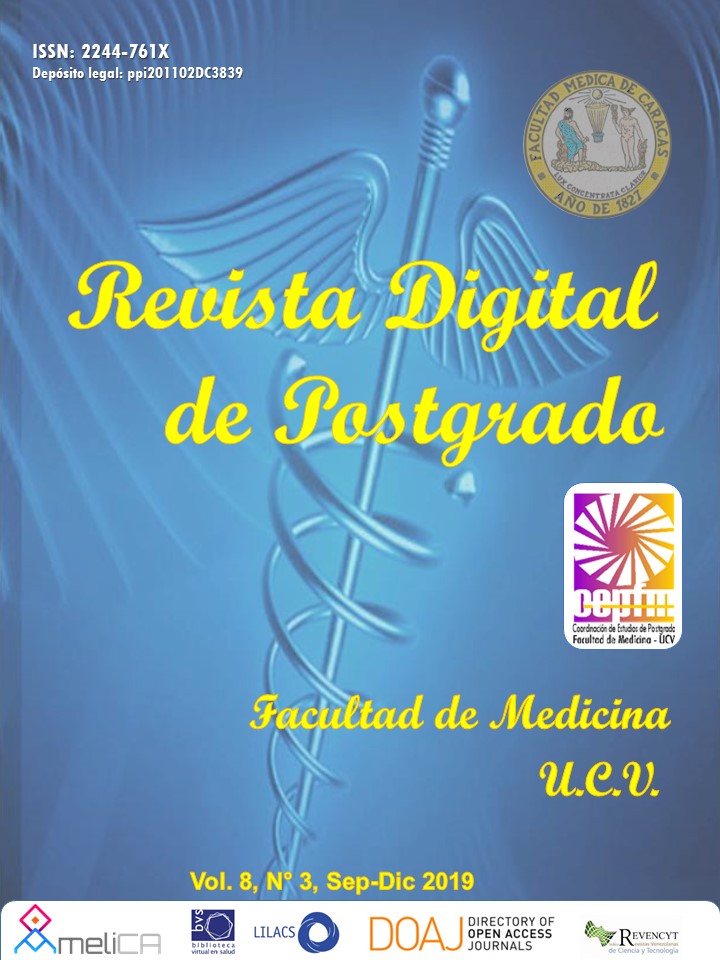Microorganisms that colonize the central venous catheters of patients hospitalized in the internal medicine service of the Dr. Miguel Pérez Carreño hospital
Keywords:
Infections, Microorganisms, Central Venous Catheter.Abstract
Introduction: intravascular catheterization is used for hemodynamic monitoring, hemodialysis, metabolic and nutritional support, fluid administration, chemotherapy and prolonged antibiotic therapy, blood and derivatives, among others. In this study, infections caused by the use of (CVC) central venous catheter are reported, as well as the microorganisms present in patients. Methods: The research was of a retrospective, descriptive and cross-sectional type, with a non-experimental research design and aimed to know, in a direct way, the reality of the problem. The observation units were (188) clinical records of the patients admitted to the internal medicine service at the Miguel Pérez Carreño Hospital in the period between January and April 2017. Results: In 30 of the patients, the culture of the tip of the central venous catheter. In 67% there was no growth of microorganisms, while 33% grew microorganisms at 24 hours. 80% of the cultivated samples report the presence of Gram-positive cocci. 10% reported enterobacteria and 10% reported yeast, finally with less frequency pseudomonas with 0%. Conclusions: Only 78 patients required placement of a central venous catheter, of which 30 catheter tips were cultured, finding that only 10 of the catheter tips were positive for infection with bacterial growth at 24 hours, with Gram-positive cocci. the main bacteria isolated in patients with CVC followed by enterobacteriaDownloads
References
Echevarria, A. Catéteres venosos Centrales. [Internet] 2014 [Citado: Febrero 23, 2019] Recuperado de: http://www.aibarra.org/Guias/1-2.htm: http://www.aibarra.org/Guias/1-2.htm
Organización Mundial de la Salud. Una atención limpia es una atención más segura. [Sitio web]. Dinamarca: OMS; 2014 [Citado: Febrero 20, 2019]. Disponible en: http://www.who.int/gpsc/background/es/
Sandoval M, Guevara A, Torres K, Viloria V. Epidemiología de las infecciones intrahospitalarias por el uso de catéteres venosos centrales. Kasmera, 2015; 41(1): 7-15.
Chávez, A. Infecciones asociadas al catéter venoso central en pacientes críticos. Unidad de cuidados intensivos "Dr. Oscar Lander". Ciudad hospitalaria Dr. Enrique Tejera. Enero-abril 2015. [Trabajo de grado] Valencia: Universidad de Carabobo; 2015
Scharager, J; Armijo, I. Metodología de la Investigación para las Ciencias Sociales [CD-ROM]: Versión 1.0. Santiago: Escuela de Psicología, SECICO Pontificia Universidad Católica de Chile; 2001.
Tamayo, M. El Proyecto de la Investigación Científica. México. Editorial Limusa; 2003.
Zambrano J, Serrano S, Quiroz S. Prevalencia de infección en pacientes con catéter venoso central. Revista Médica HJCA. 2013; 5(2):120-24.
Elcuaz, RS. Infecciones relacionadas con el catéter venoso central en pacientes con nutrición parenteral total. Nutr hosp [España]. 2012; 27(3):775-780.
Sala-Sánchez O, Rivera-Morales I. Incidencia de infecciones relacionadas a catéteres venosos centrales (CVC) en la unidad de cuidados intensivos (UCI) de un hospital universitario. Medicina Universitaria. 2010; 12(47):91-95.
Martínez, T. Uso de catéter venoso central e infecciones presentadas por los pacientes ingresados en el servicio de medicina interna del Hospital Miguel Pérez Carreño en el período comprendido entre enero y abril de 2017. [Trabajo de grado]. Caracas: Universidad Nacional Experimental “Rómulo Gallegos; 2018.
How to Cite
Issue
Section
License
Usted es libre de:
- Compartir — copiar y redistribuir el material en cualquier medio o formato
- Adaptar — remezclar, transformar y construir a partir del material
- para cualquier propósito, incluso comercialmente.
Bajo los siguientes términos:
-
Atribución — Usted debe dar crédito de manera adecuada, brindar un enlace a la licencia, e indicar si se han realizado cambios. Puede hacerlo en cualquier forma razonable, pero no de forma tal que sugiera que usted o su uso tienen el apoyo de la licenciante.
- No hay restricciones adicionales — No puede aplicar términos legales ni medidas tecnológicas que restrinjan legalmente a otras a hacer cualquier uso permitido por la licencia.











